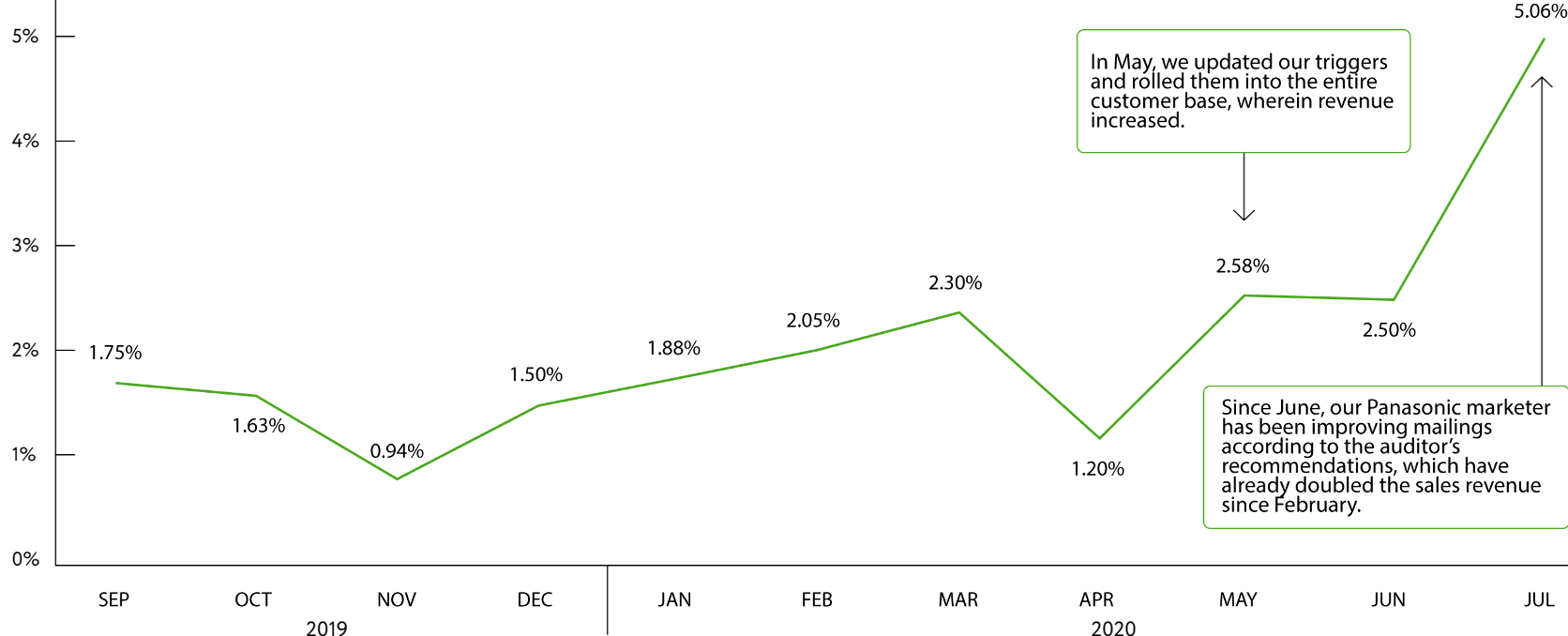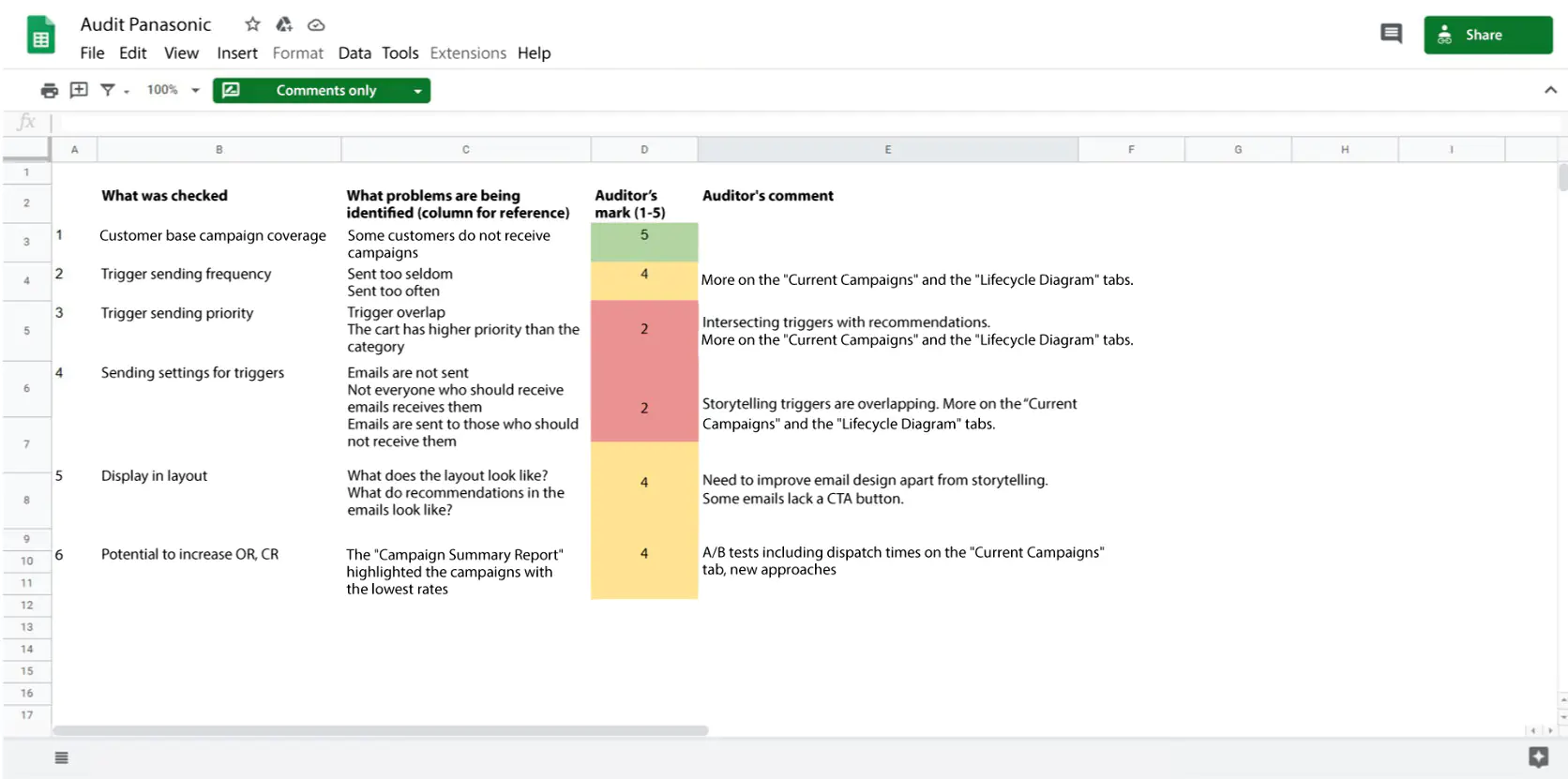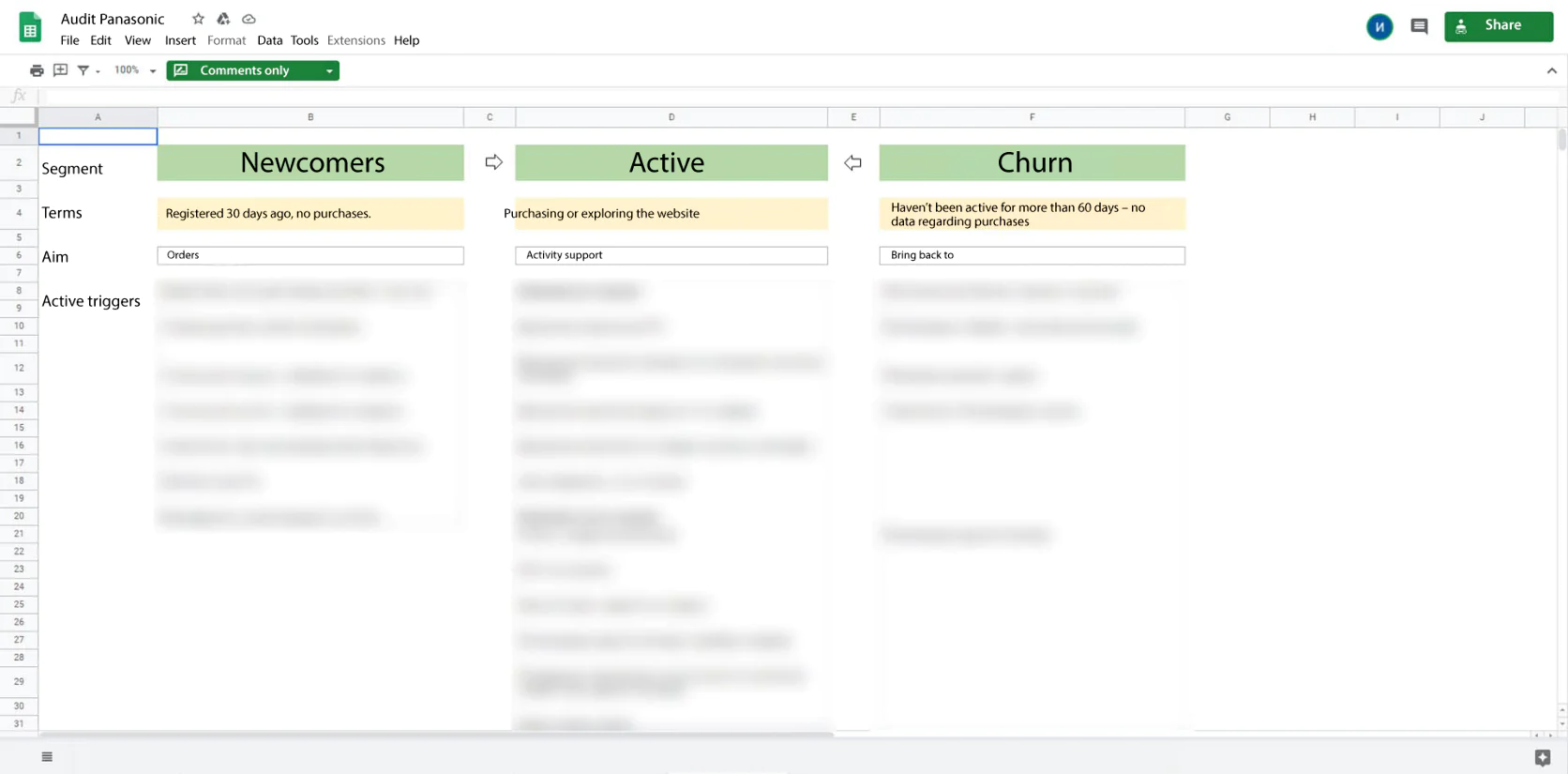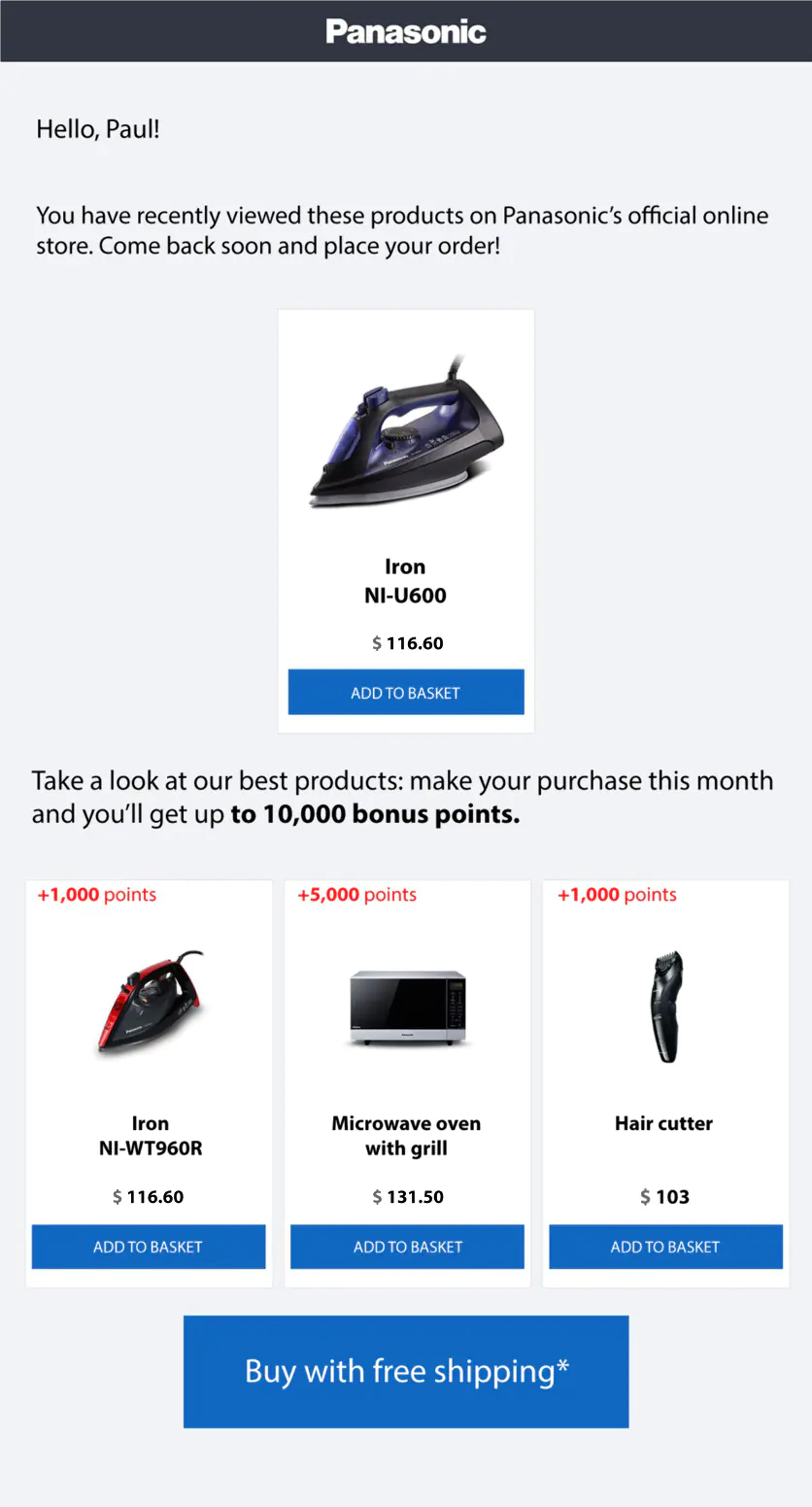46 Triggers are Better than 133: How Panasonic Carried Out a Triggered Email Audit and Saved a Quarter of the Marketer’s Time
46 Triggers are Better than 133: How Panasonic Carried Out a Triggered Email Audit and Saved a Quarter of the Marketer’s Time
Challenges
Carry out an audit of the triggered email system to maximize revenue and allow the marketer to spend less time setting up emails
Results
The share of revenue from updated triggered email campaigns in relation to the total revenue of the online store increased from 2.3% to 5.06%
The results of the triggered email audit
For the online store, the total revenue share from automated abandoned category, abandoned view, next purchase recommendations campaigns and product articles, increased on average from 2.3% to 5.06%.
We achieved this by:
- Reducing the number of triggers from 133 to only 46. We removed overlaps and duplicates when necessary and opted to get rid of emails that did not increase revenue;
- Reducing the number of abandoned cart emails per customer from 4 to 1 to minimize unsubscribers;
- Finding and identifying the customer segment that had not been covered by triggered emails and are now sending them campaigns to avoid losing revenue;
- Adding emails with recommendations for smaller categories that had not been previously included and likewise increased their coverage;
- Replacing the triggers’ manual setting with recommendations for future purchases using an automatic algorithm;
- Recommending products that fell into the same price category as customers had previously viewed on the website;
- Prioritizing sending emails for abandoned views over emails for abandoned carts to increase the likelihood of a sale;
- Segmenting the customer base according to the customer lifecycle;
- Making email templates easier to understand;
- Conducting A/B tests and improving our trigger campaigns in accordance with our auditor’s plan.
As a result, Panasonic has developed a new strategy for communication with customers, a roadmap for the future, and an increased revenue from emails with updated triggers.
Share of revenue from updated trigger email campaigns relative to total revenue

To determine the outcome of the marketing audit, we compared results from March and July, but disregarded April. In April, revenue from all campaigns, including trigger campaigns, declined. Presumably, this was caused by the pandemic and a general decline in demand for goods. Customers were less likely to add items to their shopping cart, and the number of abandoned cart emails decreased.
Share of revenue from all automated email campaigns relative to total revenue

The auditor only made partial changes to the trigger emails. The next stage was the responsibility of the marketer, who independently processed all automatic triggers and transactional campaigns according to the auditor’s recommendations. The first changes have already yielded results since the revenue share from all trigger campaigns have peaked this year.
This story explains why Panasonic decided to conduct a marketing audit, what was audited and how the trigger emails were set up.
Maestra is our permanent database operator. On the Maestra platform, and with the help of our colleagues, we have been developing our direct marketing and automated communications for several years. With our communication developments’ success, we have now reached the stage of maturity with more than 100 automated mechanics, resulting in millions in sales. So, it’s now time to take a closer look at what we’ve done, see what can be improved on, and learn how we can move forward.
Maestra’s expertise in analytics is unquestionable. When it comes to improvements and new methods of project development, who better than the platform provider to tell us which direction to take or where else we could “strike oil.”
What prompted the audit
-
133triggers were running before the audit. Some of these were duplicated and intersected, and required manual adjustment.
A year and a half before the audit, Panasonic analyzed the activity and coverage of its customer base, segmented its customers, and relaunched its online store’s website. Based on this, Panasonic completely renewed its email communication with customers by changing the logic of its trigger campaigns. It also launched reminders about abandoned views and shopping carts, started providing recommendations for viewed categories, and introduced welcome emails. Panasonic later created engaging and retention-building email chains with longer reads about products and developed reactivation campaigns to reduce churn.
Dozens of new triggers were launched using similar manual settings.One edit in email sending time or the structure of the product catalog required having to edit multiple triggers, leading to errors and wasting marketing resources.
Triggers were launched so quickly that it was nearly impossible to track down and fix all errors manually.
As a result, the company never received the maximum profit amount from its trigger campaigns. To further develop its direct marketing, Panasonic wanted to optimize its existing trigger emails and develop its customer communication strategy.
The audit was outsourced to marketing experts — and here’s why
Six years ago, Panasonic began using Maestra as its primary tool for collecting, storing and analyzing customer data as well as communicating with customers. During the first few months of cooperation, we implemented the platform and consolidated customer data from seven different sources into single profiles, developing a comprehensive loyalty program.
Panasonic requested an external audit of its trigger-based campaigns for three reasons:
First, Maestra has a lot of experience with campaigns. Their analysts know how to set up triggers, find gaps in existing campaigns and build a communication strategy.
Second, its emails ceased to increase in their profitability. In 2018, Panasonic relaunched its website and updated all email communication scenarios with customers, which resulted in a growth in profits. As growth stalled, it became clear that it was time to improve its trigger emails. To not squander resources on testing our own ideas, we decided to take action by formulating a new strategy with the help of external experts.
Third, Panasonic has only one full-time marketer responsible for direct channel communication with its customers. It would have taken a marketer a month to independently check all triggers, find errors, update scripts, and explore additional functionalities of the system. In the same vein, they would have had to put off completing all other tasks.
Audit results
Over the course of a month, the auditor checked 133 email campaign scenarios. Here’s what they looked at and what they presented in the auditor’s report:
What was checked
What was achieved
Existing trigger campaigns, how the conditions for sending these trigger emails had been configured, whether they were being sent correctly, and whether they were reaching the desired recipients;
A list and description of existing trigger campaigns and edits to them, as well as list of new triggers;
How often messages are sent via triggers, sending priority and whether or not there are any overlaps in the triggers;
An indication of which triggers do and don’t work and where they contain errors;
To what extent the customer base is covered by trigger campaigns, which customers do not receive emails and why they may not receive them;
Breakdown of triggers by customer lifecycle to reduce customer churn and recommendations on how to increase the reach of trigger emails;
How email templates are displayed in the customer’s inbox, and how product recommendations are inserted;
Advice on how to change the layout of emails;
How to improve the campaign effectiveness.
Advice on which triggers to improve on, where to launch new ones, and which A/B tests to run.

In the audit report, the analysts detailed the shortcomings of the trigger campaigns, suggested improvements and gave the marketer recommendations for future campaigns
Optimizing the trigger campaigns helped increase sales several times over the last two months for abandoned product and category browse emails.
Now I am confident that our campaigns are being sent correctly. I received an opinion from the auditor, who thoroughly tested our hypotheses and helped polish campaign settings. This acts as a benchmark to be observed in the future.
There is a detailed plan for the entire financial year, and I know which areas will require extra effort and attention. In addition, the plan is supported by the audit’s results, which helps justify specific steps and actions to our company’s management.
In any case, changes and improvements always have two sides — even with successes, there are failures. On the one hand, sales from abandoned view emails increased. On the other hand, I have dealt with individual customers who received trigger emails of items with the wrong price. I do recall that after the implementation, the number of reviews on our website decreased; however, it is not to say that the decrease occurred due to the implementation. Nevertheless, we do need to improve this aspect. All improvements are potentially risky and require a lot of attention.
What problems were found in trigger campaigns and how they were solved
Let’s take a closer look at which aspects of the trigger campaigns were changed and what the results were.
We cut down the number of triggers
-
46trigger campaigns remained following the audit and Panasonic's revenue increased
Panasonic had 133 email triggers, some of which turned out to be ineffective and didn’t result in an increase in revenue, so the auditor recommended removing or replacing them. Emails with a selection of products for newcomers had very few views and clicks. At this stage, the customer’s preferences are unknown and irrelevant products were often included in the recommendations. These emails were replaced with an email that helped to get to know the brand better.
The biggest changes affected the following campaigns:
Campaign type
Number of triggers
Before
Before
After
Abandoned category browse
24
1
Re-purchase recommendations
13
1
Long reads about products
96
44
Combining several conditions and rules in one trigger means the marketer spends less time configuring changes and settings, triggers don’t get duplicated and customers receive fewer emails. At the same time, efficiency and revenue do not decrease.
Number of triggers
Average share of campaign revenue relative to total revenue
Average time needed to set up triggers
133 triggers
19.07%
~ 4 hours
46 triggers
20.85%
~ 1 hour
We compared the indicators for three months before the audit and after, with the exception of April. In April, revenue from all campaigns decreased, including trigger emails — presumably due to the pandemic.
Overlapping triggers were removed
Sending conditions resulted in the customer receiving up to four similar emails a day. When customers looked at products from different categories in one browsing session, they received a separate email for each category with a motivational offer to return to shopping. For example:
Nick bought a blender. A month later, he looked at a razor for himself and a hairdryer for his wife but didn’t place an order. The system launched three triggers simultaneously: an offer to buy something else for the kitchen and recommendations for razors and hair dryers. As a result, Nick received three emails in one day — he considered it spam and unsubscribed.
The auditor traced all overlaps, removed duplicates and merged some triggers.
Triggers were distributed accross the entire customer base
It turned out that trigger for abandoned category browse and next purchase recommendations campaigns did not cover the entire customer base because the triggers were configured according to outdated settings. This meant Panasonic was losing revenue. The auditor set up triggers so that emails could be sent to all customers.
Related products helped increase coverage
By adding products that were not previously included in the campaigns, Panasonic managed to increase the reach of its abandoned category and recommendations for the next order emails. Before the audit, purchase recommendations were not included for small categories such as batteries. These are now also included in the campaigns.
Emails with recommendations for the next purchase were fine-tuned
To ensure that the next purchase recommendations are entirely consistent with the customer’s interest, we set up automatic recommendations and segmented them by the price of the viewed items. If the buyer views the cheapest products in the category, then the recommendations will include items with a lower price tag. The algorithm automatically selects the pricing category. This approach allows you to adjust to the customer’s expectations and increase the potential of a sale.
As a result, the order conversion rate in emails has changed:

We have seen an increase in the conversion rate via last non-direct click attribution. This is the result of combining recommendation campaigns for all product categories into one email, which was carried out in May. In addition, it is now easier for the marketer to conduct A/B tests and increase conversion rates on their own since, in a single mailing list, the audience is not divided by additional parameters, which increases the sample size.
The automatic algorithm also saves the marketer from manually setting up trigger conditions with product recommendations. In the past, changes had to be made to 13 emails for each category. Now, it is sufficient to edit only one.
Trigger campaign priority
Before the audit, abandoned category view triggers took precedence over abandoned product view triggers. It turned out that at first, customers were recommended products that were less relevant to them. For example:
Agatha chose a camera on the website but didn’t complete her purchase. She received an email with recommendations for her viewed category the next day. But the email didn’t contain the products that Agatha had already browsed and was interested in. Due to this, Agatha didn’t return to the website to make a purchase.
We changed our approach and now the customer will receive a reminder only for products that they were previously interested in.
Setting up primary customer segmentation
We segmented the entire Panasonic customer base by lifecycle, depending on where the customer is in the sales funnel. The three categories are newcomers, active, and churn.
In each category, the auditor described the triggers that Panasonic already uses. They also shared insight into which triggers are missing, which are irrelevant, where to add surveys for customers and how to test new techniques to reduce churn or stimulate a purchase. Panasonic can now build a new customer communication strategy.

The auditor distributed all triggers according to the customer’s lifecycle and made recommendations on supplementing or updating them to reduce churn
An updated email template design
Even if the triggers are configured correctly, and the message reached the recipient, the customer may not read it or click the call-to-action (CTA) button. This may be affected by the text in the header of the email, the layout, or the CTA button’s text.
We slightly updated the email template to make the recommendation structure and button name more visible and noticeable.

Before

After
How Panasonic plans to further improve trigger emails based on audit results
The auditor made significant changes to the campaigns and their settings, but the work didn’t stop there. Panasonic received suggestions on what else could be changed after the audit. The company plans to do this on its own.
As recommended by the auditor:
- Rework or disable the remaining triggers that the auditor did not update;
- Launch new triggers in relation to the customer’s lifecycle;
- Update the design of trigger campaigns since the auditor only made basic changes;
- Conduct A/B tests and check the impact of email subject lines and target button texts on click and reach metrics.
Bonus: how to conduct your own quick marketing audit
A marketing audit is worth doing if you want to increase your email revenue but are unsure of what the next step is and what to prioritize. When your time resources are limited, or you don’t have the budget for an external audit, you can check the trigger mailings yourself. Here are some simple tips:
Become a mystery shopper. Register as a new user and browse the website, adding goods to your cart. See which emails are sent to the registered email. Based on this data, make a flow and time diagram: how many emails you received, within what timeframe, and after which of your actions on the website. Compare this with your communication map. By doing this, you will understand whether all campaigns are sent on time, whether product recommendations are configured correctly, how much time passes between emails, and whether they are clogging up the customer’s inbox.
Review your campaign reports regularly. Compare the scheduled triggers and emails that were actually sent to customers. If both lists don’t match up, you’ll know where to look and find errors.
Consult with your personal customer success manager. If you use the Maestra system, then you’ll be assigned a personal manager. They can help with the technical implementation of campaigns and assist with the setup of triggers.
Brainstorm a list of A/B tests. Invite your team for a coffee and, in a relaxed atmosphere, jot down a list of potential tests. We are all human. We receive campaigns regularly and know what to expect from our daily emails.
Start optimization from campaigns for your active customer base. You won’t be able to reconfigure all campaigns at once, so prioritizing is essential.
First, work with the triggers for active customers. That way, you won’t scare them off with spam.
Secondly, think about a churn strategy. Stores like Panasonic have a long cycle between purchases and a customer can return in two years or more. It is crucial to keep in touch with them.
Finally, it’s worth considering the engagement cycle and communication strategy for new customers.



